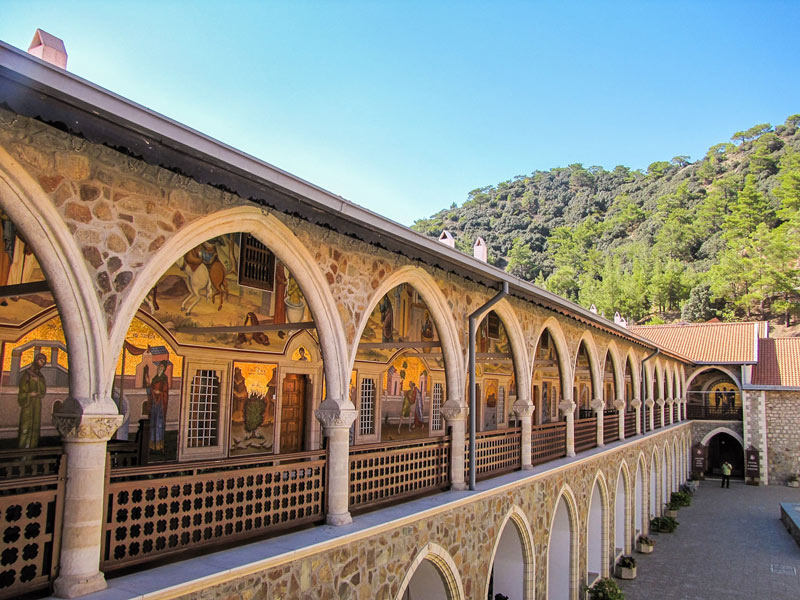Cyprus Museum
A visit to the Cyprus Museum with its magnificent collection of archaeological treasures dating back to Neolithic times is a must. Collections include astonishingly well-preserved Mycenaean pottery, Chalcolithic figurines, Egyptian and Roman statues, and carvings from the Royal Tombs at Salamis. The museum is located in central Nicosia.
Kourion, Limassol
With its spectacular Greco-Roman theatre, agora (marketplace) and the remains of a cathedral, plus a villa, the House of Eustolios, with well-preserved 5th century floor mosaics, the ancient city-kingdom site of the Kourion is the finest archaeological site on the island. On the same site is a stadium and sanctuary.
Kyrenia
Once an important Roman and Venetian port and said to be one of the most picturesque harbours in the Mediterranean, Kyrenia is a busy north Cyprus town dominated by a vast fortress. Kyrenia Castle houses a Shipwreck Museum, which is best known for its 2,300-year-old merchant vessel and amphorae display.
Lefkara
This charming village between Limassol and Larnaca is famous for its silver filigree and, significantly, its lace. Legend has it the Italian painter Leonardo da Vinci visited Lefkara in the 15th century and purchased some of its lefkaritika lace for the cathedral in Milan, and in doing so secured its fame.
Petra tou Romiou
A landmark of Cyprus and said to be where the Greek goddess Aphrodite was born, Petra tou Romiou (Rock of Aphrodite) is one of the most beautiful spots on the island. Turquoise sea surrounds the rock. Nearby, is the Temple of Aphrodite on the site of the ancient city of Palaipafos.
Phoinikoudes, Larnaca
A 3 km (2 miles) or so long esplanade lined with palm trees, the Phoinikoudes (locally Foinikoudes) is the icon image of Larnaca. Here, visitors can relax on the beach or dine on seafood while looking out over the Mediterranean. At one end lies Larnaca’s marina and at the other its famous fort.
Tombs of the Kings
Dating from the ancient Hellenistic and Roman period, this collection of rock cut tombs have helped to earn Paphos UNESCO World Heritage status in its entirety. The tombs were of noblemen, rather than kings, and are historically important because of their design; some resemble houses with a Peristyle atrium courtyard.
Troodos Painted Churches
Dating back to Byzantine times, this collection of 10 richly painted churches and tiny monasteries are a UNESCO World Heritage Site. Two of the most spectacular are the Agios Nikolaos tis Stegis at Kakopetria with frescos from the 11th century, and Panagia tou Araka with scenes from the Old Testament.
Ayia Napa
Once the hedonistic capital of Cyprus, Agia Napa has ‘grown up’ and now has a growing number of sophisticated nightspots, restaurants and cultural venues, as well as lively clubs that still attract the young, trendy set. The resort has some of the best beaches and diving opportunities on the island.
Baths of Aphrodite
An isolated freshwater pool on the edge of the Akamas Peninsula, the Baths of Aphrodite near Polis is where, so legend has it, the Greek goddess bathed and enjoyed trysts with the god Adonis. Today, the natural beauty of the untouched countryside is as much an attraction as the grotto.
Eat chocolate
Indulge your taste buds on the slopes of the Troodos Mountains at the Platres chocolate workshop. The owners import all chocolate from Venezuela, and have entered the Guinness Book of World Records for making the world's most expensive Easter egg.
Hala Sultan Tekke
Located near Larnaca International Airport, the Hala Sultan Tekke is a beautiful 19th century mosque set amongst palm trees. It overlooks Larnaca’s Salt Lake where migratory flamingos stay in winter. Considered one of the most sacred Muslim shrines, the mosque contains an ancient tomb and is a place of pilgrimage.
Kykkos Monastery
Kykkos Monastery is the largest and most famous monastery in Cyprus. Founded in AD1100 by the Byzantine emperor Alexios Komnenos, the monastery is dedicated to the Virgin Mary and is home to one of the three surviving icons painted by the Apostle Luke. Kykkos Monastery is ornately decorated and covered in a silver gilt, enclosed in a tortoiseshell shrine. It is also famous for its museum, located within the monastery grounds, which houses an impressive collection of icons, woodcarvings and manuscripts, and other Cypriot antiquities. The nearby Troodos Mountains, with magnificent hills and valleys, should also be explored as they are home to nine Byzantine churches, included on UNESCO's World Heritage list, and richly decorated with murals and Byzantine paintings.
Nicosia
The walled city of Nicosia is a mix of old and new. Visit the Old Town full of quaint tavernas housed in Venetian mansions. Top attractions include the Archbishop's Palace, the spectacular Byzantine Art Museum, St John's Cathedral with beautiful frescos, the House of Hadjigeorgiakis Kornesios and the Ömeriye Mosque.
Paphos Harbour
Be serenaded whilst gazing at the beautiful medieval fort that dominates the picturesque harbour at Paphos. It's worth seeing anytime of the year, but particularly during the summer festival when operatic sounds reverberate around the ancient walls. Nearby, you can see Paphos’s world-famous mosaics that show scenes from Greek mythology.
Saint Hilarion Castle
The magnificent ruins of Saint Hilarion castle tower out of the limestone rocks of the mountains overlooking Kyrenia. Its turrets and walls built on sheer rock make it is one of the finest sights in northern Cyprus. See the remains of its chapel, royal apartments, banqueting hall, courtyards and stables.
Skiing
Both Platres and Kakopetria are conveniently placed for the skiing season on Mount Olympus, which usually lasts from January to mid March, but Troodos is actually the nearest resort to the skiing area.
Troodos Mountains
Take in the spectacular scenery of the forested Troodos Mountains where you can enjoy hiking and cycling trails, nature reserves, churches and the famous Kykkos Monastery. In winter, resorts offer skiing on the snow-covered peaks, including Mount Olympus, which at 1,952m (6,404ft) above sea level, is the island’s highest point.
